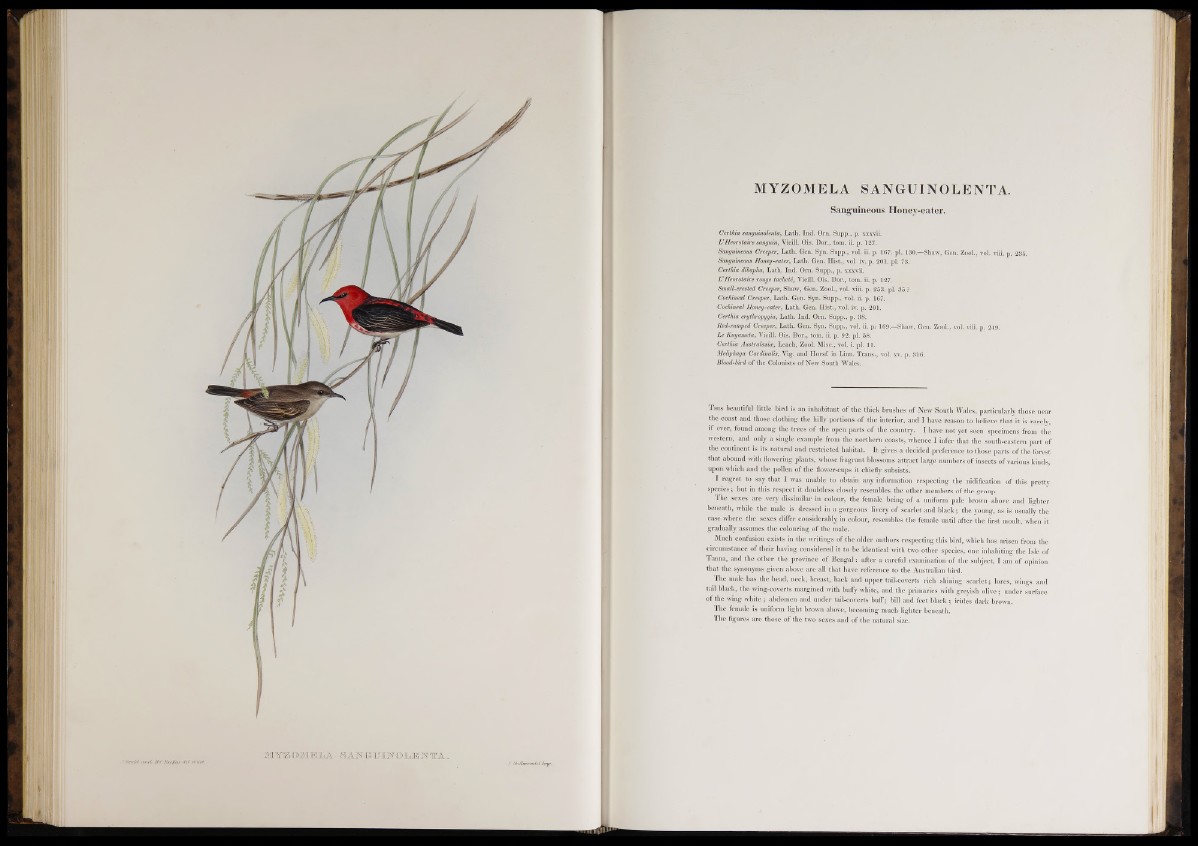
M Ï Z O M B i i A S A J T O IT IB 'O lL iB jS r T A
MYZOMELA SANGUINOLENTA.
Sanguineous Honey-eater.
Certhia sanguinolenta, Lath. Ind. Orn. Supp., p. xxxvii.
L’Heorotaire sanguin, Vieill. Ois. Dor., tom. ii. p. 127.
Sanguineous Creeper, Lath. Gen. Syn. Supp., vol. ii. p. 167. pi. 130—Shaw, Gen. Zool., vol. viii. p. 235.
Sanguineous Honey-eater, Lath. Gen. Hist., vol. iv. p. 201. pi. 73.
Certhia dibapha, Lath. Ind. Om. Supp., p. xxxvii.
L’Heorotaire rouge tacheté, Vieill. Ois. Dor., tom. ii. p. 127.
Small-crested Creeper, Shaw, Gen. Zool., vol. viii. p. 253. pi. 35 ?
Cochineal Creeper, Lath. Gen. Syn. Supp., vol. ii. p. 167.
Cochineal Honey-eater, Lath. Gen. Hist., vol. iv. p. 201.
Certhia erythropygia, Lath. Ind. Orn. Supp., p. 38.
Red-rumped Creeper, Lath. Gen. Syn. Supp., vol. ii. jm 169.—Shaw, Gen. Zool., vol. viii. p. 249.
Le Kuyameta, Vieill. Ois. Dor., tom. ii. p. 92. pi. 58.
Certhia Australasia, Leach, Zool. Misc., vol. i. pi. 11.
Meliphaga Cardinalis, Vig. and Horsf. in Linn. Trans., vol. xv. p. 316.
Blood-bird of the Colonists of New South Wales.
T h is beautiful little bird is an inhabitant of the thick brushes of New South Wales, particularly those near
the coast and those clothing the hilly portions o f the interior, and I have reason to believe that it is rarely,
if ever, found among the trees of the open parts of the country. I have not yet seen specimens from the
western, and only a single example from the northern coasts, whence I infer that the south-eastern part of
the continent is its natural and restricted habitat. It gives a decided preference to those parts of the forest
that abound with flowering plants, whose fragrant blossoms attract large numbers of insects o f various kinds,
upon which and the pollen of the flower-cups it chiefly subsists.
I regret to say that I was unable to obtain any information respecting the nidification o f this pretty
species; but in this respect it doubtless closely resembles the other members o f the group.
The sexes are very dissimilar in colour, the female being of a uniform pale brown above and lighter
beneath, while the male is dressed in a gorgeous livery of scarlet and black; the young, as is usually the
case where the sexes differ considerably in colour, resembles the female until after the first moult, when it
gradually assumes the colouring of the male.
Much confusion exists in the writings of the older authors respecting this hird, which has arisen from the
circumstance o f their haring considered it to-be identical with two other species, one inhabiting the Isle of
Tanna, and the other the province o f Bengal: after a careful examination of the subject, I am o f opinion
that the synonyms given above are all that have reference to the Australian bird.
The male has the head, neck, breast, back and upper tail-coverts rich shining scarlet; lores, wings and
tail black, the wing-coverts margined with huffy White, and the primaries with greyish olive; under surface
of the wing white ; abdomen and under tail-coverts buff; bill and feet black ; irides dark brown.
The female is uniform light brown above, becoming much lighter beneath.
The figures are those of the two sexes and of the natural size.